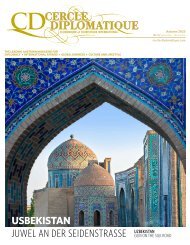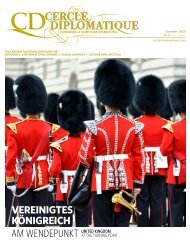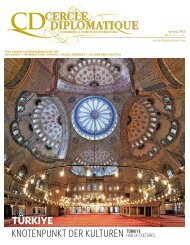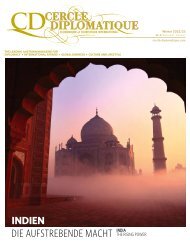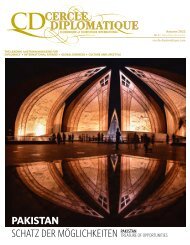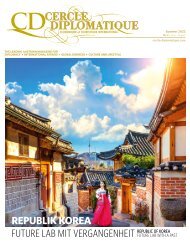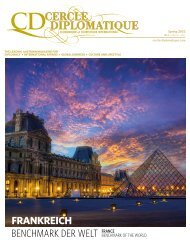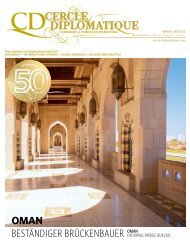CERCLE DIPLOMATIQUE - issue 03/2020
CD is an independent and impartial magazine and is the medium of communication between foreign representatives of international and UN-organisations based in Vienna and the Austrian political classes, business, culture and tourism. CD features up-to-date information about and for the diplomatic corps, international organisations, society, politics, business, tourism, fashion and culture. Furthermore CD introduces the new ambassadors in Austria and informs about designations, awards and top-events. Interviews with leading personalities, country reports from all over the world and the presentation of Austria as a host country complement the wide range oft he magazine.
CD is an independent and impartial magazine and is the medium of communication between foreign representatives of international and UN-organisations based in Vienna and the Austrian political classes, business, culture and tourism. CD features up-to-date information about and for the diplomatic corps, international organisations, society, politics, business, tourism, fashion and culture. Furthermore CD introduces the new ambassadors in Austria and informs about designations, awards and top-events. Interviews with leading personalities, country reports from all over the world and the presentation of Austria as a host country complement the wide range oft he magazine.
Create successful ePaper yourself
Turn your PDF publications into a flip-book with our unique Google optimized e-Paper software.
SAVOIR VIVRE NEW CULTURAL PERSPECTIVES
Forschung & Museum | Research at the museum
Naturhistorisches Museum Wien | Natural History Museum Vienna
Text & Interview: Rois & Stubenrauch
INFO
KATRIN VOHLAND
Die aus Hamburg stammende, promovierte Biologin
leitete zuletzt den Forschungsbereich „Museum und
Gesellschaft“ am Museum für Naturkunde Berlin. Seit Juni
2020 ist Katrin Vohland Generaldirektorin des
Naturhistorischen Museums Wien.
Vision Dialogue.
Katrin Vohland, neue Generaldirektorin
des Naturhistorischen Museums
Wien, sieht die Stärke des Hauses in
der interdisziplinären Zusammenarbeit
und setzt auf Biodiversitätsforschung.
Katrin Vohland, the new Director General
of the Natural History Museum Vienna,
considers interdisciplinary collaboration
the institution’s greatest strength and wants
to focus on biodiversity research.
Das Naturhistorische Museum Wien ist auch eine der
größten außeruniversitären Forschungseinrichtungen
Österreichs – ein Aspekt, den Sie dem Publikum stärker
vermitteln möchten.
Gemeinsam mit den Wissenschaftlerinnen und
Wissenschaftlern im Hause möchte ich die Forschungsprozesse
in den verschiedenen Ausstellungen
der Schausäle sichtbarer machen. Fragen wie
„Welche Schlüsse kann man aus den Objekten ziehen,
aus ihren Fundorten, ihrer Materialität, ihren
Beziehungen zueinander?“, sollen stärker beleuchtet
werden. Das Museum hat ja eine bedeutende Tradition
als Evolutionsmuseum. Ich möchte die Prozesse
hinter der Evolution sichtbarer machen, die Entstehung
von Diversität und Vielfalt, die Selektionsmechanismen,
den Einfluss des Menschen.
In welchen Feldern der Forschung ist das NHM Wien
führend?
Eine Besonderheit des Hauses ist, dass sowohl Natur-,
Sozial- und Geisteswissenschaften zusammenarbeiten.
Entsprechend kann das NHM Wien in den
Bereichen federführend wirken, wo diese Interdisziplinarität
zum Tragen kommt. Ein Beispiel sind die
Arbeiten der Prähistorie in Hallstatt: Das Zusammenarbeiten
von Paläobotanikern, die Pollen und
Getreidekerne analysieren können, der Archäologinnen,
die in den bronzezeitlichen Bergwerken Ausgrabungen
leiten, und der Geologen, die die Tektonik
beforschen, führt zu bahnbrechenden Einsichten.
PHOTOS: NHM WIEN, C. RITT / K. KRACHER; NHM WIEN; INSEQ
Eines der ersten Projekte unter Ihrer Ägide ist die
Einrichtung des „Deck 50“, eines neuen Ortes für
Wissenschaftskommunikation.
Das Deck 50 ist ein Raum, wo wir anhand ausgewählter
Objekte mit Hilfe digitaler Formate wissenschaftsbasiert
aktuelle Fragen behandeln. Das Besondere
ist, dass Meinungen und Einschätzungen
der Öffentlichkeit an die Wissenschaftlerinnen und
Wissenschaftler zurückgespielt werden. Hier werden
wir viel experimentieren.
Das virtuelle Museum wird als Ergänzung zum herkömmlichen
Museumsbetrieb immer wichtiger.
Mir ist die Verbindung zwischen digitalen Angeboten
und den Objekten selbst wichtig. Menschen
sollen verstärkt digitale Angebote nutzen können,
um sich auf ihren Besuch im NHM Wien vorzubereiten
oder während und im Nachgang des Besuches
zu spannenden Objekten vertiefende Geschichten
erleben zu können. Eine weitere wichtige Zielgruppe
ist die Wissenschaft selbst. Unter dem Schlagwort
„Open Science“ wollen wir Informationen über unsere
wissenschaftlichen Sammlungen besser zugänglich
machen.
Werden Sie auch in Ihrem eigenen Fachgebiet, der
Biodiversität, Schwerpunkte setzen?
Das Museum mit seiner großen Expertise in rezenten
und historischen Mensch-Natur Beziehungen
wird wichtige Beiträge für den Bereich der
Nachhaltigkeit leisten. Es gibt bereits viel Expertise
im Bereich der Biodiversitätsforschung – also der
Vielfalt der Tiere und Pflanzen, ihrer Verbreitung,
ihrer Bedeutung in Ökosystemen für Nahrungsmittelsicherheit,
Klimaschutz oder das Wohlbefinden
von Menschen generell.
The Natural History Museum Vienna is one of the largest
non-university research institutes in Austria – a fact that you
wish to communicate more strongly to visitors.
Together with the museum’s scientists, I want to
render visible the research processes that underlie
the various exhibitions in the showrooms. Questions
such as what conclusions can be drawn from an object,
from its finding place, its material composition,
its relationship with other objects, should receive
more attention. The museum is continuing its tradition
as a museum about evolution. I want to make
evolutionary processes, the emergence of diversity
and variety, selection mechanisms, and its influence
on people visible.
In which research areas does the Natural History Museum
Vienna lead the way?
One of the things that make the museum special
is the collaboration between natural and social scientists,
as well as humanities scholars. Accordingly, the
Natural History Museum Vienna leads in those areas
where this level of interdisciplinary engagement comes
into effect. One example is the prehistoric works
in Hallstatt: The collaboration between palaeobotanists,
who analyse pollen and grain kernels, archaeologists,
who conduct excavations in Bronze Age mines,
and geologists, who study tectonics, is leading to
ground-breaking insights.
One of the first projects under your leadership is the
establishment of the “Deck 50”, a new place for science
communication.
Deck 50 is a room where we – based on selected
objects – use digital formats to address current scientific
questions. The unique thing about it is that opinions
and assessments from the public are played
back to the scientists. We will experiment a lot here.
The virtual museum is becoming increasingly important as a
supplement to conventional museum operations.
For me, the connection between digital offers
and the objects themselves is important. People
should be able to make greater use of digital offers in
preparation for their visit to the Natural History
Museum Vienna or to experience in-depth stories
during and after seeing the exciting objects in person.
Another important target group is science
itself. Under the keyword “Open Science“, we want
to make information about our scientific collections
more accessible.
Will you also set priorities in your own area of expertise,
biodiversity?
The museum, with its great expertise when it comes
to the recent as well as historical relationship
between man and nature, will make important contributions
to the field of sustainability. We already
have a great deal of expert knowledge in the field of
biodiversity research – i.e. the diversity of animals
and plants, their distribution, their importance for
food security in ecosystems, climate protection or
the well-being of people in general.
Aktuelle Sonderausstellung
im Naturhistorischen
Museum Wien
Current exhibitions
Ablaufdatum!
Wenn aus Lebensmittel Müll wird.
Best Before!
When Food Becomes Waste.
18.11.2020-16.05.2021
Deck 50 eröffnet Ende
November 2020.
Deck 50 launches at the end of
November 2020.
Online-Sammlung des NHM
Wien:
Online collection of the Natural
History Museum Vienna:
objekte.nhm-wien.ac.at/home
Deck 50, neuer Ort für Wissenschaftskommunikation.
Deck 50, a new place for science
communication.
INFO:
NATURHISTORISCHES MUSEUM
WIEN
1010 Wien, Burgring 7
Eingang / Entrance:
Maria-Theresien-Platz
nhm-wien.ac.at
The Hamburg-born biologist with a doctorate in biology
most recently headed the research area “Museum and
Society“ at the Museum of Natural History in Berlin.
Katrin Vohland has been Director General of the Natural
History Museum Vienna since June 2020.
Forschungsfelder des NHM:
Bronzezeitliche Textilien und
Meteoritenimpakte. Illustration
von Ferdinand Bauer.
Research fields of the NHM: Bronze
Age textiles and meteorite impacts.
Illustration by Ferdinand Bauer.
122 Cercle Diplomatique 3/2020
Cercle Diplomatique 3/2020 123





